Shipbuilders use a torque wrench to tighten a stud for the tail cap on a propeller shaft for Gerald R. Ford (CVN78). Photo by Chris Oxley – click for larger
Workers at Huntington Ingalls Industries (NYSE:HII) tension the bolts that will keep the 30-ton bronze propeller affixed to one of the 4 shafts protruding from the hull of the U.S. Navy’s nuclear aircraft carrier Gerald R. Ford (CVN 78).
The 21-foot propellers were cast and milled of solid bronze by Rolls-Royce at their facility in Pascagoula, Mississippi. Rolls-Royce Senior Vice President Jay McFadyen commented in a phone conversation this afternoon that the propellers are slightly smaller in diameter than the propellers found on the Nimitz-class aircraft carrier, however they’ve been optimized from a hydrodynamic and a surface porosity standpoint for greater efficiency. He notes that the propellers take approximately two months to build and were delivered by truck to the yard in Virginia.
“Installation of the propellers culminates more than 10 months of focused work by numerous trades in support of installing the underwater shafting,” said Rolf Bartschi, Newport News Shipbuilding’s vice president, CVN 78 carrier construction. “The configuration of the blades, the weight of the propellers and the extremely tight tolerances required make this a challenging installation. I commend the rigging and machinery installation mechanics for a job well done.”
WATCH: Gerald R. Ford Build Sequence: Keel-laying to Launch in Under Two Minutes [VIDEO]
Gerald R. Ford’s primary hull structure reached 100 percent structural completion in May, bringing more than three years of structural erection work to a close. Work continues on the ship, including the piping and electrical systems and the habitability areas such as the galley and mess spaces.
The ship’s christening is scheduled for Nov. 9.

 Join The Club
Join The Club











